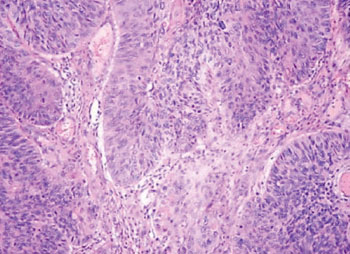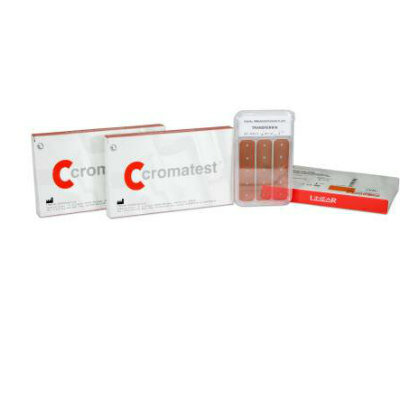Biomarker Analysis Reveals Treatment Targets in Anal Cancer
By LabMedica International staff writers
Posted on 17 Jun 2015
Squamous cell anal carcinoma is a rare, human papillomavirus (HPV)-associated malignancy accounting for 2% of digestive system cancers and usually these malignancies are detected early and successfully managed with chemoradiation.Posted on 17 Jun 2015
Uncommonly, these cancers recur or present with metastases and cisplatin and 5-fluorouracil represent the only endorsed regimens. Beyond standard therapy, few therapeutic options exist and to identify other novel, potential targets and therapeutic options for this disease, a multiplatform approach has been utilized.

Image: Histopathology of a biopsy smear from a patient with squamous cell carcinoma in the anal canal showing proliferation of atypical cells that infiltrate the stromal (Photo courtesy of Muñiz Hospital).
Scientists at Roswell Park Cancer Institute, (Buffalo, NY, USA) and their colleagues analyzed 212 squamous cell anal carcinoma specimens. These were tested via a multiplatform profiling service consisting of gene sequencing (Sanger or next generation sequencing [NGS]), protein expression (immunohistochemistry [IHC]) and gene amplification using chromogenic in situ hybridization (CISH) or fluorescent in situ hybridization (FISH). Tissue from a metastatic site was submitted in 80.2% of the cases. Documentation of positive HPV or human immunodeficiency virus (HIV) status was provided in six cases.
The multiplatform profiling service was provided by Caris Life Sciences (Phoenix, AZ, USA). The team found evidence of significant IHC overexpression in several genes: Multidrug resistance-associated protein 1 (MRP1), in 97.6% of the analyzed samples; Epidermal growth factor receptor (EGFR), 89.7%; Topoisomerase (DNA) I, (TOPO1), 68.3%; O-6-Methylguanine-DNA Methyltransferase (MGMT), 67.2%; and phosphatase and tensin homolog (PTEN), 46.9%. Additionally, high mutation rates were seen in biomarkers associated with the phosphatidylinositol-4,5-bisphosphate 3-kinase, catalytic subunit alpha/ v-akt murine thymoma viral oncogene homolog 1 (PIK3CA/Akt) pathway. PIK3CA exon 9 mutations were detected in 75% of all PIK3CA mutations. Point mutations in other genes were also identified, including a few co-occurring mutations.
The authors concluded that multiplatform tumor profiling identified several potential targets. Protein expression aberrations identified potential treatment options not routinely considered. Mutations in several genes indicate potential for targeting the phosphatidylinositol-3-kinase (PI3) pathway. Differences in anal carcinomas whose etiology is of viral origin may present different treatment options based on the driver mutations. The study was presented at the ASCO meeting held during May 22 to June 2, 2015, in Chicago (IL, USA).
Related Links:
Roswell Park Cancer Institute
Caris Life Sciences













